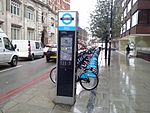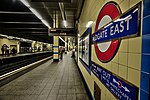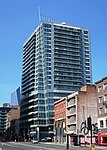St George's German Lutheran Church
18th-century Lutheran churches18th-century churches in the United KingdomBuildings and structures in WhitechapelChurches completed in 1762Churches in the London Borough of Tower Hamlets ... and 6 more
Churches preserved by the Historic Chapels TrustGrade II* listed buildings in the London Borough of Tower HamletsGrade II* listed churches in LondonLutheran churches in LondonUse British English from February 2015Whitechapel

St George's German Lutheran Church is a church in Alie Street, Whitechapel just to the east of the City of London. From its foundation in 1762 until 1995 it was used by German Lutherans. Today the small vestry serves as an office for the Historic Chapels Trust and the church is available for hire for secular events. St George's was the fifth Lutheran church to be built in London. It is now the oldest surviving German Lutheran church in the United Kingdom.
Excerpt from the Wikipedia article St George's German Lutheran Church (License: CC BY-SA 3.0, Authors, Images).St George's German Lutheran Church
Alie Street, London Whitechapel
Geographical coordinates (GPS) Address Website External links Nearby Places Show on map
Geographical coordinates (GPS)
| Latitude | Longitude |
|---|---|
| N 51.514166666667 ° | E -0.070555555555556 ° |
Address
St. George's German Lutheran Church
Alie Street 55
E1 8EB London, Whitechapel
England, United Kingdom
Open on Google Maps







